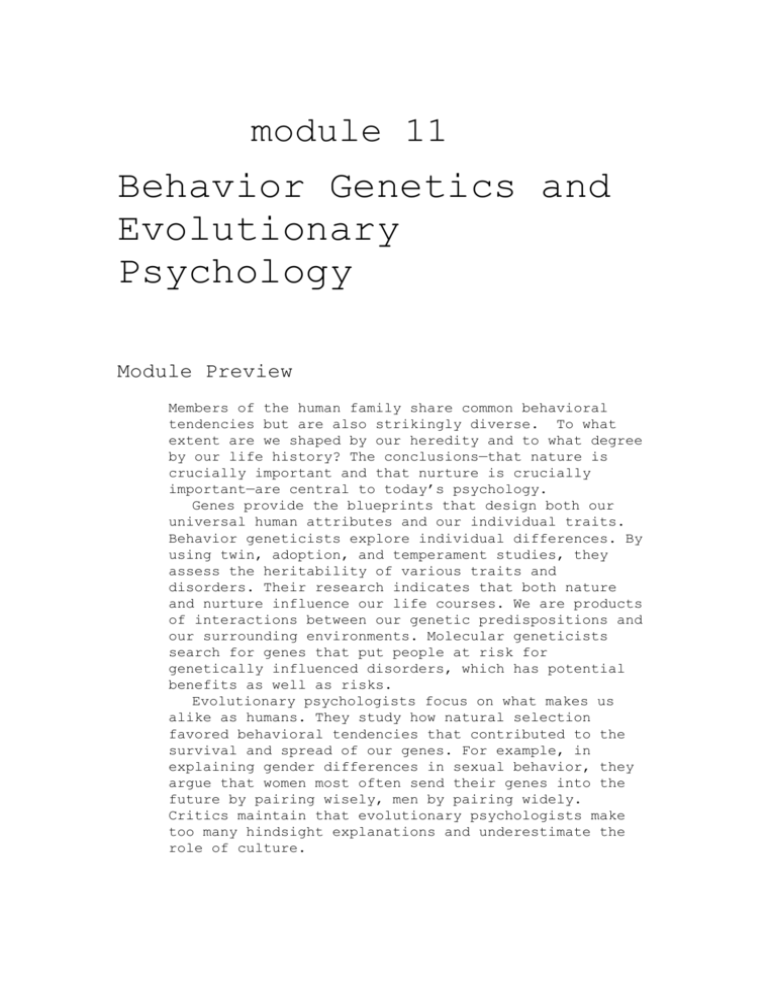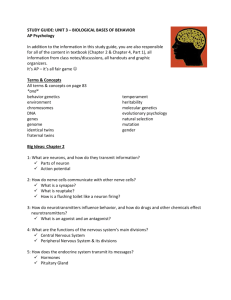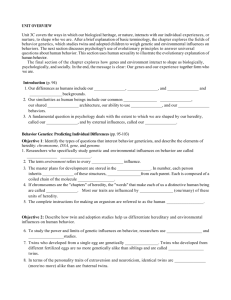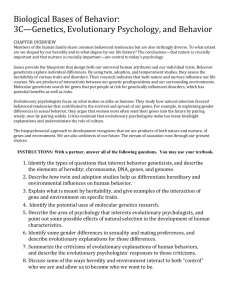module 11 Behavior Genetics and Evolutionary Psychology Module
advertisement

module 11 Behavior Genetics and Evolutionary Psychology Module Preview Members of the human family share common behavioral tendencies but are also strikingly diverse. To what extent are we shaped by our heredity and to what degree by our life history? The conclusions—that nature is crucially important and that nurture is crucially important—are central to today’s psychology. Genes provide the blueprints that design both our universal human attributes and our individual traits. Behavior geneticists explore individual differences. By using twin, adoption, and temperament studies, they assess the heritability of various traits and disorders. Their research indicates that both nature and nurture influence our life courses. We are products of interactions between our genetic predispositions and our surrounding environments. Molecular geneticists search for genes that put people at risk for genetically influenced disorders, which has potential benefits as well as risks. Evolutionary psychologists focus on what makes us alike as humans. They study how natural selection favored behavioral tendencies that contributed to the survival and spread of our genes. For example, in explaining gender differences in sexual behavior, they argue that women most often send their genes into the future by pairing wisely, men by pairing widely. Critics maintain that evolutionary psychologists make too many hindsight explanations and underestimate the role of culture. Module Guide Introductory Exercise: Fact or Falsehood? Lecture: Universal People 11-1. Give examples of differences and similarities within the human family, noting how they are shaped by our genes and our environment. Members of the human family differ in personality, interests, culture, and family background. At the same time, our shared brain architecture predisposes us to sense the world, develop language, and experience hunger through the same mechanisms. Humans everywhere affiliate, conform, reciprocate favors, punish offenses, and grieve a child’s death. Our genes and our environment contribute to our striking diversity and shared human nature. Behavior Genetics: Predicting Individual Differences Lectures: The Origins of Blue Eyes; The Genetic Revolution Exercise: Genetic Factors Exercise/Project: Genetic Influences Instructor Video Tool Kit: Ethics in Human Research: Violating One’s Privacy 11-2. Identify the types of questions that interest behavior geneticists, and describe the elements of heredity: chromosome, DNA, genes, and genome. Behavior geneticists study our differences and aim to determine the relative importance of heredity and environment on behavior. Environment includes every nongenetic influence, from prenatal nutrition to the people and things around us. Every cell nucleus contains the genetic master code for the body. Within each cell are 46 chromosomes with 23 donated by each parent. Each chromosome is composed of a coiled chain of a molecule, called DNA (deoxyribonucleic acid). Genes are DNA segments that, when “turned on” (active or expressed), provide the code for the production of protein molecules. By directing the manufacture of proteins, the approximately 30,000 genes that compose the human body determine our physical development. The genome provides the complete instructions for making an organism, consisting of all the genetic material in the organism’s chromosomes. Variations at particular gene sites in the DNA define each person’s uniqueness. Human traits are influenced by many genes interacting with the environment. Lectures: The Minnesota Twin Study; “Mom Always Liked You Best” Exercise: Striking Similarities Videos: Module 16 of The Mind series, 2nd ed.: The Effect of Aging on Cognitive Functioning: Nature/Nurture Instructor Video Tool Kit: Nature Versus Nurture: Growing up Apart 11-3. Describe how twin and adoption studies help us differentiate hereditary and environmental influences on human behavior. Comparisons of identical twins, who are genetic clones, and fraternal twins, who develop from separate eggs, help behavior geneticists tease apart the effects of heredity and environment. On both extraversion and neuroticism, identical twins are much more similar than fraternal twins. The discovery that identical twins separated at birth show remarkable similarities also suggests genetic influence. Indeed, separated fraternal twins do not exhibit similarities comparable to those of separated identical twins. However, shared genes can translate into shared experiences. Adoption studies enable comparisons with both genetic and environmental relatives. Adoptees’ traits bear more similarities to their biological parents than to their caregiving adoptive parents. Nonetheless, the latter do influence their children’s attitudes, values, manners, faith, and politics. Clearly, nature and nurture shape one’s developing personality. Exercise: EAS Temperament Survey Video: Segment 23 of the Scientific American Frontiers series, 2nd ed.: Bringing up Monkey 11-4. Discuss how the relative stability of our temperament illustrates the influence of heredity on development. An infant’s temperament is his or her characteristic emotional excitability and intensity. From the first weeks of life, some babies are more relaxed and cheerful, while others are difficult (more tense and irritable). Still others are slow to warm up. These differences in temperament tend to endure. For example, the most emotionally intense preschoolers tend to be relatively intense young adults. Compared with fraternal twins, identical twins have more similar temperaments, indicating that heredity may predispose temperament differences. Lectures: Genetic Influences on Psychological Traits; Nature and Nurture; Gene-Environment Correlation Feature Film: Fly Away Home and Imprinting ActivePsych: Scientific American Frontiers, 3rd ed.: Genes and Personality: Understanding Williams Syndrome Instructor Video Tool Kit: 100-Years-Old and Counting: Psychological and Biological Factors; Genes and Personality 11-5. Explain what is meant by heritability, and give examples of the interaction of gene and environment on specific traits. Heritability describes the extent to which variation among members of a group can be attributed to genes. If the heritability of intelligence is 50 percent, this does not mean that one’s intelligence is 50 percent genetic. Instead, it means that we can attribute to genetic influence 50 percent of the observed variation among people. Our genes affect how our environment reacts to and influences us. Nature enables nurture. Because of human adaptability, most psychologically interesting traits are expressed in particular environments. In other words, genes are self-regulating; they can react differently in different environments. We are all the products of interactions between our genetic predispositions and our surrounding environments. For example, a stressful environment can trigger genes that affect the production of neurotransmitters that underlie depression. Breastfeeding boosts later intelligence only for the 90 percent of infants with a gene that assists in breaking down fatty acids present in human milk. Similarly, a baby who is genetically predisposed to be social and easy going may, in contrast to one who is less so, attract more affectionate and stimulating care and thus develop into a warmer and more outgoing person. Lecture: Designer Babies? Videos: Module 12 of The Brain series, 2nd ed.: Huntington’s Disease; Segment 22 of the Scientific American Frontiers series, 2nd ed.: Bypass Genes Instructor Video Tool Kit: Designer Babies Feature Film: Gattaca and “Designer Babies” 11-6. Identify the potential uses of molecular genetics research. Molecular geneticists study the molecular structure and function of genes. They seek to identify specific genes influencing behavior. In labs worldwide, molecular geneticists are teaming with psychologists to identify genes that put people at risk for genetically influenced disorders. Potentially, steps may be taken to prevent problems before they happen. With this benefit, however, also comes risks of labeling people in ways that may lead to discrimination. Prenatal screening poses hopeful possibilities but also difficult problems as parents become able to select their children’s traits. In China and India, where boys are highly valued, testing for an offspring’s sex has enabled selective abortions. Millions of parents will select for health and perhaps for brains and beauty. However, by “selecting” out certain traits, we may deprive ourselves of future Handels, van Goghs, Lincolns, and Dickinsons, who were all troubled people. Evolutionary Psychology: Understanding Human Nature Lectures: Evolutionary Psychology; Misunderstanding Evolutionary Theory and Psychology Exercises: Evolutionary Psychology; Darwinian Grandparenting PsychSim 5: Mind-Reading Monkeys Instructor Video Tool Kit: The Nature-Nurture Issue 11-7. Describe the area of psychology that interests evolutionary psychologists, and point out some possible effects of natural selection in the development of human characteristics. Evolutionary psychologists focus on what makes us so much alike as humans. They study how natural selection has shaped our universal behavioral tendencies. Natural selection is the principle that, among the range of inherited trait variations, those that lead to increased reproduction and survival will most likely be passed on to succeeding generations. Nature selects beneficial variations from among the mutations (random errors in gene replication) and the new gene combinations produced at each human conception. During human ancestry, genes that enable today’s capacity to learn and adapt had survival value. Similarly, we love the taste of fats and sweets, which once were hard to come by but which prepared our ancestors to survive famines. This particular natural disposition is mismatched with today’s junk-food environment. Lectures: Gender Differences in Sexuality; Evolutionary Theory and Gender Differences in Motivation; Infidelity; Evolutionary Psychology and the Coolidge Effect Exercises: Mate Preferences; Hendrick Sexual Attitudes Scale PsychSim 5: Dating and Mating Instructor Video Tool Kit: Evolutionary Psychology and Sex Differences; Openness to Casual Sex: A Study of Men Versus Women 11-8. Identify some gender differences in sexuality and mating preferences, and describe evolutionary explanations for those differences. Gender refers to the biologically and socially influenced characteristics by which people define male and female. One of the largest reported gender differences is women’s greater disapproval of and lesser willingness to engage in casual, uncommitted sex. In comparison to women, men think more about sex, masturbate more often, are more likely to initiate sex, and make more sacrifices to gain sex. Evolutionary psychologists apply the principle of natural selection to explain women’s more relational and men’s more recreational approaches to sex. Compared with eggs, sperm are cheap. While a woman usually incubates and nurses one infant at a time, a man can spread his genes by impregnating other females. Women most often send their genes into the future by pairing wisely, men by pairing widely. Women increase their own and children’s chances of survival by searching for mates with economic resources and social status. Being attracted to healthy, fertile-appearing partners increases men’s chances of spreading their genes widely. 11-9. Summarize the criticisms of evolutionary explanations of human behaviors, and describe the evolutionary psychologists’ responses to those criticisms. Critics argue that evolutionary psychologists start with an effect (e.g., gender sexuality difference) and work backward to propose an explanation. In addition, much of who we are is not hard-wired. Cultural expectations shape the genders. Still others suggest that evolutionary explanations may undercut moral responsibility. In response, evolutionary psychologists point to the explanatory power of their theoretical principles, especially those offering testable predictions. They also note that understanding our propensities may help us to overcome them.






